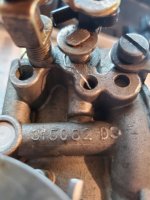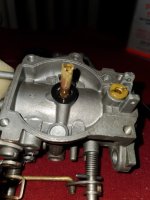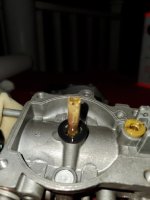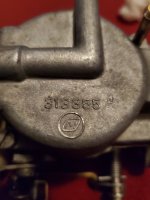Answer to first question likely to be asked: No. I do not have a model number. I've yet to even identify the year, or whether or not the powerhead is truly a 25 or if it's an 18 (part numbers match across the board for the 72s, except for the high speed orifice and reed stops--even the cylinder bores and exhaust tubes are identical). This is a "frankenstein" outboard recently given to me. Model number on the non-original transom bracket comes back as a '66 18 Evinrude. Top cover decals are 25 Johnson, matching the designs of the '77 model. No idea whatsoever of the lower unit down. Paint scheme does not match transom bracket and the powerhead mounting hardware is incorrect (I had to add shims to eliminate slack, and the existing rubber shock pads showed no cracks, deterioration, or missing parts; the pads mismatched their bushings by approximately 1/8 inch per each 4, resulting in the slack). So the powehead has at least been previously removed if not transplanted from another outboard. All-in-all, it has the overall smell of an outboard someone pieced together from a scrap heap as something to sell for spare cash. My uncle bought it and gifted it directly to me.
So no reliable model number. Though I do have the powerhead's serial stamp, If there remains anyone with access to OMC's or BRP's factory records, I would be grateful for the reverse lookup. That stamp number is E3602142.
So to the topic...
The motor was long overdue for some love. Combined, my father and I have freed the seized cylinders, freed the seized electric starter, replaced the start solenoid and related wiring/button switch. Thoroughly cleaned the points ignition system, repaired a seriously worn and sloppy magneto plate (caused by upside-down support ring--fixed that too), precision-calibrated the breaker points, fixed incorrectly synchronized cam follower to the throttle plate, and rebuilt the carb.
First crank and run--in what likely had been decades--was a remarkable success, given the powerhead's initial condition and ignoring imperfections in its operation. We did note symptoms of air bubbles entering the fuel system while otherwise running extremely rich throughout the entire throttle range. We had almost the entirety of the low speed, with engine stalling still within the lower portion but where still expected to idle. Subsequent fuel delivery system inspection showed no leaks (new line and primer bulb) between the tank and fuel pump. Did not disassemble the fuel pump as blow-through tests at both the inlet and outlet met expectations with positively no pressure leaks (no fuel visible in the cylinder port). Replaced the fuel line from the pump to the carb; though we found no signs of leaking, the line was very old and brittle.
After several more test runs, I did finally noticed a very slight amount of fuel leaking from the carb bowl gasket. I retorqued the screws, odd that all 4 should be not "loose" but loosened from the threadlock used during the rebuild. Following test run showed no improvements. So I tore down the carb for a more careful inspection and cleaning. This time, I noticed that the high-speed nozzle had some damage at its bottom end, where it enters the top port of the high-speed orifice housing. It appeared as though someone had attempted to remove it with a flathead screwdriver, as the slots resembled the slipped head of a screw and were slightly flared out. Additionally, there was a long burr extending down. Looking into the high-speed port, there was a corresponding davit on the mating surface. That burr was preventing the bowl from completely mating to the carb body. I resolved the issue by sanding the burr off with 220 grit sandpaper. Additionally, I sanded the flared ends so that the diameter matched the rest of the nozzle. Recleaned in order to eliminate metallic dust. The bowl now seats securely to the carb body, screws maintain their torque, and no further signs of fuel leaking.
This time, the test run showed a significant difference in operation. A lot of power was restored, though not nearly all. The motor no longer surges with symptoms of fuel aeration. But the previously rich fuel mixture has turned to a near drowning flood. Still, throughout the entire throttle range. At low RPM, even the slow-speed needle makes no noticeable improvements even when rotated to a max-lean stop. However, flooding does worsen after rotating the needle several turns towards the rich. Motor behavior is consistent with no misses, hesitations, or stalls beyond lower idle speed. Spark plugs have so far not fouled, though I pull and dry them between each test run. No pooled fuel remaining in either cylinder.
Compression tests are 118 top and 116 bottom, cold. No tests have been made at running temp.
I'm not a mechanic, nor am I "expertly" knowledgeable of carburetors. But that nozzle remains the only unrepaired component I know to find. From experience with other OMC outboards of similar design, I have seen that high-speed valve adjustments can also impact low RPM performance on models that have that adjustment available. So I'm suspecting that the damaged end of that nozzle could be enabling excess fuel flow up and into the barrel. But again, I lack the working knowledge to prove or disprove that theory.
I see there's no part number for that nozzle, nor is it even shown on OMC parts diagrams. So I'm assuming I cannot order a new replacement. I do have a good mind to attempt fabricating one, as it doesn't appear to be a complicated part. Has anyone else had any relatable experience? And if so, how were you able to resolve it? Additionally, should I be looking for another less obvious cause?
So no reliable model number. Though I do have the powerhead's serial stamp, If there remains anyone with access to OMC's or BRP's factory records, I would be grateful for the reverse lookup. That stamp number is E3602142.
So to the topic...
The motor was long overdue for some love. Combined, my father and I have freed the seized cylinders, freed the seized electric starter, replaced the start solenoid and related wiring/button switch. Thoroughly cleaned the points ignition system, repaired a seriously worn and sloppy magneto plate (caused by upside-down support ring--fixed that too), precision-calibrated the breaker points, fixed incorrectly synchronized cam follower to the throttle plate, and rebuilt the carb.
First crank and run--in what likely had been decades--was a remarkable success, given the powerhead's initial condition and ignoring imperfections in its operation. We did note symptoms of air bubbles entering the fuel system while otherwise running extremely rich throughout the entire throttle range. We had almost the entirety of the low speed, with engine stalling still within the lower portion but where still expected to idle. Subsequent fuel delivery system inspection showed no leaks (new line and primer bulb) between the tank and fuel pump. Did not disassemble the fuel pump as blow-through tests at both the inlet and outlet met expectations with positively no pressure leaks (no fuel visible in the cylinder port). Replaced the fuel line from the pump to the carb; though we found no signs of leaking, the line was very old and brittle.
After several more test runs, I did finally noticed a very slight amount of fuel leaking from the carb bowl gasket. I retorqued the screws, odd that all 4 should be not "loose" but loosened from the threadlock used during the rebuild. Following test run showed no improvements. So I tore down the carb for a more careful inspection and cleaning. This time, I noticed that the high-speed nozzle had some damage at its bottom end, where it enters the top port of the high-speed orifice housing. It appeared as though someone had attempted to remove it with a flathead screwdriver, as the slots resembled the slipped head of a screw and were slightly flared out. Additionally, there was a long burr extending down. Looking into the high-speed port, there was a corresponding davit on the mating surface. That burr was preventing the bowl from completely mating to the carb body. I resolved the issue by sanding the burr off with 220 grit sandpaper. Additionally, I sanded the flared ends so that the diameter matched the rest of the nozzle. Recleaned in order to eliminate metallic dust. The bowl now seats securely to the carb body, screws maintain their torque, and no further signs of fuel leaking.
This time, the test run showed a significant difference in operation. A lot of power was restored, though not nearly all. The motor no longer surges with symptoms of fuel aeration. But the previously rich fuel mixture has turned to a near drowning flood. Still, throughout the entire throttle range. At low RPM, even the slow-speed needle makes no noticeable improvements even when rotated to a max-lean stop. However, flooding does worsen after rotating the needle several turns towards the rich. Motor behavior is consistent with no misses, hesitations, or stalls beyond lower idle speed. Spark plugs have so far not fouled, though I pull and dry them between each test run. No pooled fuel remaining in either cylinder.
Compression tests are 118 top and 116 bottom, cold. No tests have been made at running temp.
I'm not a mechanic, nor am I "expertly" knowledgeable of carburetors. But that nozzle remains the only unrepaired component I know to find. From experience with other OMC outboards of similar design, I have seen that high-speed valve adjustments can also impact low RPM performance on models that have that adjustment available. So I'm suspecting that the damaged end of that nozzle could be enabling excess fuel flow up and into the barrel. But again, I lack the working knowledge to prove or disprove that theory.
I see there's no part number for that nozzle, nor is it even shown on OMC parts diagrams. So I'm assuming I cannot order a new replacement. I do have a good mind to attempt fabricating one, as it doesn't appear to be a complicated part. Has anyone else had any relatable experience? And if so, how were you able to resolve it? Additionally, should I be looking for another less obvious cause?





